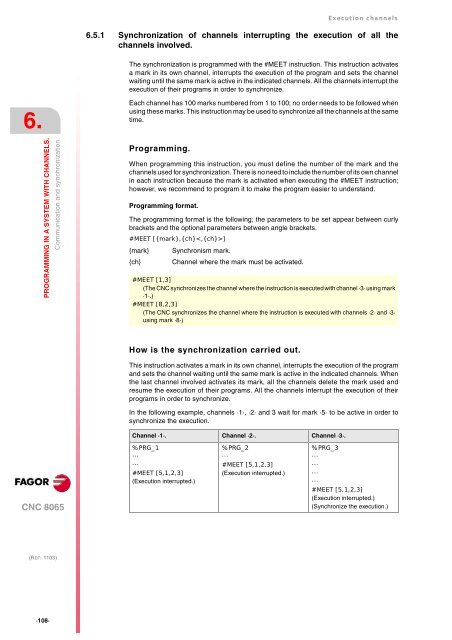EN: man_8065_chn.pdf - Fagor Automation
EN: man_8065_chn.pdf - Fagor Automation
EN: man_8065_chn.pdf - Fagor Automation
You also want an ePaper? Increase the reach of your titles
YUMPU automatically turns print PDFs into web optimized ePapers that Google loves.
6.<br />
PROGRAMMING IN A SYSTEM WITH CHANNELS.<br />
CNC <strong>8065</strong><br />
(REF: 1103)<br />
·108·<br />
Communication and synchronization.<br />
Execution channels<br />
6.5.1 Synchronization of channels interrupting the execution of all the<br />
channels involved.<br />
The synchronization is programmed with the #MEET instruction. This instruction activates<br />
a mark in its own channel, interrupts the execution of the program and sets the channel<br />
waiting until the same mark is active in the indicated channels. All the channels interrupt the<br />
execution of their programs in order to synchronize.<br />
Each channel has 100 marks numbered from 1 to 100; no order needs to be followed when<br />
using these marks. This instruction may be used to synchronize all the channels at the same<br />
time.<br />
Programming.<br />
When programming this instruction, you must define the number of the mark and the<br />
channels used for synchronization. There is no need to include the number of its own channel<br />
in each instruction because the mark is activated when executing the #MEET instruction;<br />
however, we recommend to program it to make the program easier to understand.<br />
Programming format.<br />
The programming format is the following; the parameters to be set appear between curly<br />
brackets and the optional parameters between angle brackets.<br />
#MEET [{mark},{ch}]<br />
{mark} Synchronism mark.<br />
{ch} Channel where the mark must be activated.<br />
#MEET [1,3]<br />
(The CNC synchronizes the channel where the instruction is executed with channel ·3· using mark<br />
·1·.)<br />
#MEET [8,2,3]<br />
(The CNC synchronizes the channel where the instruction is executed with channels ·2· and ·3·<br />
using mark ·8·)<br />
How is the synchronization carried out.<br />
This instruction activates a mark in its own channel, interrupts the execution of the program<br />
and sets the channel waiting until the same mark is active in the indicated channels. When<br />
the last channel involved activates its mark, all the channels delete the mark used and<br />
resume the execution of their programs. All the channels interrupt the execution of their<br />
programs in order to synchronize.<br />
In the following example, channels ·1·, ·2· and 3 wait for mark ·5· to be active in order to<br />
synchronize the execution.<br />
Channel ·1·. Channel ·2·. Channel ·3·.<br />
%PRG_1<br />
···<br />
···<br />
#MEET [5,1,2,3]<br />
(Execution interrupted.)<br />
%PRG_2<br />
···<br />
#MEET [5,1,2,3]<br />
(Execution interrupted.)<br />
%PRG_3<br />
···<br />
···<br />
···<br />
···<br />
#MEET [5,1,2,3]<br />
(Execution interrupted.)<br />
(Synchronize the execution.)
















